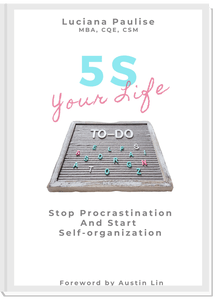
5S Your Life: Stop Procrastination and Start Self-Organization by Luciana Paulise, MBA, CQE, CSM.
ISBN 9798667931515 (July 2020). 202 pages. US$14.98 (paperback).
Engineering managers deploy quality management tools and techniques with the ultimate goal of improving customer satisfaction. Domain 6 of the Engineering Management Body of Knowledge (EMBOK) discusses the role of quality management as engineers integrate a variety of skills to successfully practice our craft. Much of today’s approach to quality management derives from the implementation of the Toyota Production System (TPS). Continuous improvement built on tools, like 5S, results in cost- and time-savings, increased profitability, and enhanced product performance.
Luciana Paulise is a true quality champion. Her new book, 5S Your Life, not only teaches us the basics of 5S but also provides real-life examples in which organizational productivity increased due to implementing this quality tool. Part I (Self-Organization vs. Procrastination) dedicates a chapter to each tool. Part II (5S for Leaders) addresses the challenges of supporting continuous improvement, including the required long-term cultural changes necessary for success. The Appendix offers case studies of 5S in manufacturing, food service, administration, transportation, retail, and healthcare.
Part 1: The 5S Tools
If you are not already familiar with 5S, Paulise starts the book with a concise definition: “5S is a culture, a set of habits that drive individual productivity and team self-organization through a lean workplace” (pg. 16). To be successful with any quality initiative, organizations must adapt their behaviors and performance to adopt a new culture with a focus on continuous improvement. Starting with the 5S tools is foundational to enhancing quality. The five steps are:
-
Sort
-
Store
-
Shine
-
Standardize
-
Self-organize
Benefits of 5S implementation include a better organized and safer workplace with increased respect and commitment from team members.
Chapter 1: Sort
The first step in 5S is to sort, meaning you must decide what you need so that you can eliminate unnecessary items and clutter. In a lean manufacturing environment, waste of time or materials are costs. So, the first principle of 5S is to find everything in less than 30 seconds (pg. 27). Not only do teams save time and money when they can quickly locate needed items, an organized workplace leads to less frustration and increased productivity.
One factor that differentiates 5S Your Life from other quality books are the numerous real-life images and “microsteps” that you can use to immediately make an impact. For example, the chapter on sort includes microsteps to identify ownership and responsibility for each work area, separate the needed from unneeded, and remove waste.
Chapter 2: Store
Safety is an important consideration for engineering managers. Having a proper place to store materials, supplies, and tools can improve the environment within a facility. Storing in 5S means organizing which includes prioritizing which items are used frequently and which need to be available nearby only.
The microsteps involved with storing, according to Paulise, are prioritizing what you need, defining a home for ease of use, and replacing immediately after use. In reading this chapter, I was reminded of my mother’s constant pleading to “Put it back where you got it from.” Although children are not necessarily good at organizing a tidy workspace, quality and efficiency can improve when we know where to access an item and put it back in its place when finished with it.
Another element of “store” includes “standardize,” discussed in Chapter 4.
Chapter 3: Shine
Shine involves cleanliness and maintenance so that the workplace stays organized after completing the first of the two steps in 5S. How many times have you heard of a person spraining an ankle or breaking a bone because they tripped over a wayward child’s or pet’s toy? In a workplace, we hear of slips, trips, or falls on oily surfaces from leaking equipment. Maintaining equipment and tools through shine can prevent accidents.
Paulise summarizes the third S as “Do not get dirty in the first place” (pg. 63). This means performing and logging routine maintenance because small issues can become complex problems if not handled quickly and appropriately. An individual must be assigned to maintenance and all team members are responsible to report issues. One great tip in the book is to flag items needing repair and placing them in a special bin with the appropriate department.
Chapter 4: Standardize
In any new process, a team must work through a few cycles to fully grasp task requirements, responsibility, and authority. In the fourth step of 5S, standardize helps the team to find the best process to consistently sort, store, and shine the workplace. Paulise recommends visual aids and provides numerous examples of before and after photos throughout 5S Your Life. These images provide evidence for success of the methodology as well as giving teams samples to emulate in their own quest for better quality and higher efficiency.
As indicated in the second S, store, standardize includes maintaining items in their proper place. However, many items used in a factory or shop are consumed on a regular basis, such as nails in a carpentry shop. Combining the microsteps within store and standardize, the team will re-order supplies when the inventory drops to an agreed-upon level. In this way, clutter is avoided (sort) and the right amount of material is available when and where it is needed (store). Again, visual aids are recommended by the author, such as drawing a red line on a liquid container to indicate that if the level is below the line, re-ordering is necessary.
Chapter 5: Self-Organization
Finally, self-organization means a cultural change to make 5S an everyday part of your life. It means “training the team to achieve… even when no one is in control” (pg. 107). Transforming these elements into seamless and consistent habits allows continuous improvement – the kaizen of quality.
Self-organization includes audits, especially when a team is first implementing 5S. Paulise also suggests holding a “5S Day” emphasizing the importance of the methodology and giving team members time to work on sorting, storing, and shining, for example. Sharing success stories from one area of the facility with another also leads to healthy competition and continuous improvement.
Part 2: 5S for Leaders
Leadership support for any work process generates team member buy-in and long-term success. Viewing 5S as a starting point for quality improvement, leaders can charter a 5S committee (pg. 132-133) to provide implementation guidance. The author also recommends an experienced facilitator, or coach, to help with cultural change and adoption of the 5S practices.
Tools to Complement 5S
Many of the tools that are described in the final section of 5S Your Life are familiar to quality management experts. Leadership, routines, and practices collectively drive continuous improvement. Here are a few of the tools described in the book (pg. 140-164). Certified Professional Engineering Managers (CPEM) will be familiar with most, if not all, of these tools from the ASEM Body of Knowledge.
- Five whys
- Fishbone diagram
- FMEA (Failure Mode and Effects Analysis)
- TPM (Total Productive Maintenance)
- Poka-yoke
- Kanban
- SMED (Single-Minute Exchange of Die)
- Spaghetti diagram
Conclusion
5s Your Life: Stop Procrastinating and Start Self-Organizing is a great introduction to the initial steps necessary to initiate change and improve quality in the workplace. Not only is each step (sort, store, shine, standardize, and self-organize) described in detail, case studies and visual examples support implementation. It is easy for engineering, operations, and maintenance managers to compare their workplace with images of best practice organizations in the book.
In addition to the step-by-step implementation guide for 5S, Paulise breaks down each step into several microsteps. As a team focuses on any one of the steps, they can measure progress against these microsteps which can also serve as a checklist for continuous improvement. The author also gives tips on implementing 5S into our homes that today serve many purposes: cooking, sleeping, working, and schooling.
I have personally been working on “sorting” to eliminate excess materials from my home and “storing” to keep what’s necessary for work and hobbies nearby the places I use them. I think you will likewise be inspired to clean and organize your work and personal spaces when you read Luciana Paulise’s 5S Your Life.
About the Author

Teresa Jurgens-Kowal is writer, speaker, and facilitator. Teresa founded Global NP Solutions to help organizations learn, adopt, transform, and sustain innovation. She frequently presents keynote presentations on innovation and design thinking.
Teresa is the co-editor of the PDMA Body of Knowledge 2nd edition and is the author of a popular book on innovation, The Innovation ANSWER Book.
Prior to founding Global NP Solutions, Teresa worked in R&D, process technology, innovation at ExxonMobil Chemical Company. She has degrees in Chemical Engineering and an MBA. She is a Certified Professional Engineering Manager. You can reach Teresa at info@globalnpsolutions.com.
